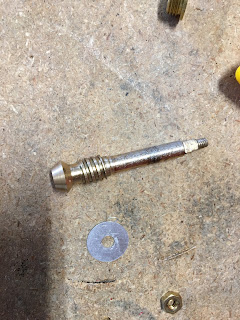One of the fun pieces of designing the steampunk-inspired lamp was the light switch. There are some cool light switches out there (link, link) but they tend to be wall switches and not lamp switches. While researching, I came across the idea of using a water valve as the light switch. Something that fits nicely with the "pipe" theme I have going on and is unexpected for a light switch.
With that in mind, I purchased a set of short pipes, switch and a valve.
The first step is to take the valve apart. The instructions warn, "It will likely be extremely tight, so you probably won't be able to
simply hold the valve body in one hand and turn the wrench with the
other."
I confidently put the valve in my vise, pulled out a pair of pliers and tried to turn it. All I got for my trouble was a mess.
I got out the vice-grips, tightened them down and tried them. They literally tore the valve body metal edges off, but it would not budge.
I was worried that I had purchased a valve with the stem welded together or something. I eventually tightened down the vice-grips to the point where they dug into the metal and used my sledge hammer to hammer on the vice-grips and finally it gave way.
I ended up with a useless piece of metal:
When the next valve arrived in the mail, I started with the vice-grips and sledge technique and got it off with minimal distortion.
Next came the switch, while it would fit inside it wouldn't stay centered.
The source page was no help, just vaguely referring to some glue and epoxy to hold it together.
I eventually poured quick-set epoxy into the base of the unit while I held the switch in place on top. It worked and the switch was centered below the opening and able to spin.
Next up was drilling out the hole so that instead of moving the valve up and down, it spins easily.
Fortunately this was pretty straightforward and went smoothly.
Then came the all-important "putting it all together"
Sadly, the shaft stuck down so far the threads would not engage. Looking at the shaft, I had hoped to glue the head to the switch, but I had to either grind away the threads on it or shorten the length. I opted to cut off the end:
That gave me the right amount of clearance. The valve-stem holder had enough clearance to screw on, the valve-stem spun freely and and sat nicely on top of the switch.
All I had to do was glue the valve-step to the top of the switch so when I turned it, it would also turn the switch.
I dropped some epoxy on the switch, closed it all up tight, waited my 5 minutes and.....
The valve handle spun freely. Opening it up, the epoxy didn't stick to the switch plastic.
I scuffed up the top of the switch to give the epoxy something to bite onto and tried again.
same problem, the epoxy pops off the plastic switch housing...seriously, who makes switches out of epoxy-proof plastic!
I'm going to try some super-glue and see if that will work... I am so close!!


















